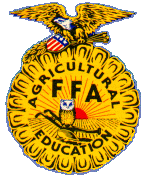
According to the 1995-1996 FFA Organization Manual, following the passage of the Smith-Hughes National Vocational Education act of 1917 the planning of an organization for students interested in vocational agriculture began. In the early 1920's, the state of Virginia, under the guidance of Henry Groseclose ,a pioneer in vocational agriculture, formed a Future Farmers Club for boys enrolled in agricultural classes. From there a national organization was founded in 1928 in Kansas City, Missouri. By 1934, Alaska and Rhode Island were the only states without chartered associations. In 1950, FFA was granted a federal charter by Congress, thus making it an integral part of public agricultural instruction. In 1969, girls were allowed to become members. FFA has since changed its name from the Future Farmers of America, as it is commonly known, to the The National FFA Organization.
The FFA operates on local, state and national levels and its agricultural education program provides students with a well-rounded, practical approach to learning through classroom education. It focuses on agricultural topics, hands-on supervised career experience, as well as provides leadership opportunities, and challenges students' agricultural skills. Nationally, there are some 444,497 members ranging from the ages of 12-21.
FFA helps students develop their leadership skills by participating in public speaking, skill contests, chapter meetings, award and recognition programs, committees and community projects. Moreover, FFA also motivates young people to make positive contributions to their schools, homes, communities and ultimately, their country.
Click for the National FFA Oranization Website.
image credit: The National FFA Organization Website


 E-Mail The Family Farm Project
E-Mail The Family Farm Project